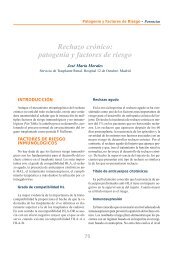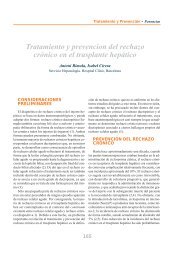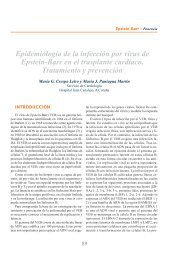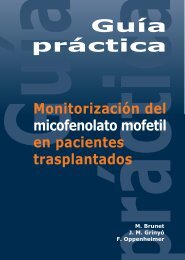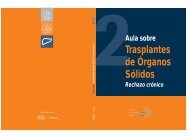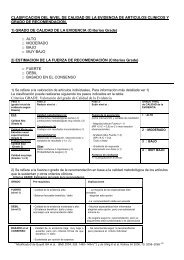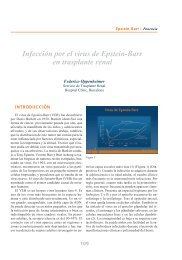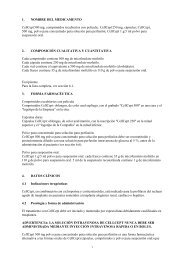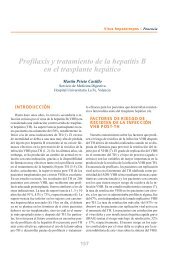Untitled - Roche Trasplantes
Untitled - Roche Trasplantes
Untitled - Roche Trasplantes
You also want an ePaper? Increase the reach of your titles
YUMPU automatically turns print PDFs into web optimized ePapers that Google loves.
BIOPSIA DE PROTOCOLO EN EL TRASPLANTE RENAL<br />
thophysiology of chronic destruction of the renal transplant and the linkage between the<br />
underlying pathology and the observed functional changes.<br />
THE RISK OF GRAFT COMPLICATIONS<br />
In order to justify the use of protocol or surveillance percutaneous needle-core biopsies<br />
they must yield a low risk of complications including graft loss and morbidity such as admission<br />
to hospital and hemorrhage. A variety of reports of the risk of major complications<br />
including substantial bleeding, macroscopic hematuria with ureteric obstruction, peritonitis<br />
or graft loss is approximately 1% (3-5). Minor complication include macroscopic<br />
hematuria in 3.5%, perirenal hematomas 2.5%, asymptomatic arterio-venous fistulas<br />
7.3% and vasovagal reactions 0.5% (5).<br />
Loss of the graft after protocol biopsy is in the region of 0.03%, based on various reports<br />
where the losses are recorded as: 0 from 2,127 biopsies (4), 1 from 1,171 (5), 0 of 328<br />
(6), 0 from 1,037 (3), 0 from 961 biopsies (7), 0 from 277 (8), and 1 from 151 (9).<br />
The risk of renal allograft biopsy is increased when needles larger that 18G are used<br />
(6); when the biopsy is undertaken for clinical indications (presumably because the indication<br />
demands higher risks, or the graft is essentially unstable prior to the biopsy);<br />
and when the kidney is in an intraperitoneal position. Safety of protocol biopsies should<br />
thus be maximized through use of a skilled operator; mandatory ultrasound guidance<br />
immediately prior to biopsy to identify any unsuspected lesions such as urinary obstruction<br />
or an arterio-venous fistula; and use of an automated spring loaded gun mechanism<br />
rather than a manual cannula and trocar. Some operators suggest the use of<br />
a 16-gauge needle (10) and a single pass, rather than the 18-gauge needle favoured<br />
by many units but with more than one needle core sample (5). Certain exclusion criteria<br />
are also required to ensure that inappropriate risks are not taken. Table I details<br />
inclusion and exclusion criteria that should be considered prior to protocol biopsy. It<br />
would be appropriate for all of the inclusion criteria to be required to be met, but exclusion<br />
should require only a single criterion to be met. This is a conservative position<br />
designed to reduce the morbidity of the procedure undertaken with a lower yield of<br />
therapeutic decision making than occurs with acute clinically indicated biopsies. In particular,<br />
the use of ultrasound not only localises the kidney accurately, but also identifies<br />
potential sources of complication, the commonest of which is partial ureteric obstruction.<br />
RELIABILITY OF PROTOCOL HISTOLOGY RESULTS<br />
How good is the biopsy as a sample of the kidney? The reliability of a given result is related<br />
to the amount of tissue obtained and to the variability if the histological finding within<br />
the kidney. Clearly very patchy events are seen with less reliability than homogeneous<br />
14




